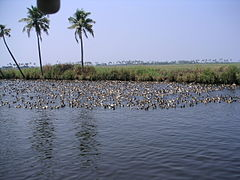Free Courses Sale ends Soon, Get It Now


Free Courses Sale ends Soon, Get It Now



Disclaimer: Copyright infringement is not intended.
Context:
Details of the findings:
|
Ashtamudi wetland |
●Ashtamudi Lake, in the Kollam District of the Indian state of Kerala. ●It possesses a unique wetland ecosystem and a large palm-shaped water body, second only in size to the Vembanad estuary ecosystem of the state. ●Ashtamudi means 'eight hills or peaks' in the local Malayalam language. ●Area: 61.42 km² ●Inflow source: Kallada River ●Ashtamudi wetland was designated a Ramsar site in 2002 due to its extraordinary importance for hydrological functions, biodiversity, and support for fish. ●This designation underscores the significance of addressing the issue of microplastic pollution in the lake. |
Source:
|
PRACTICE QUESTION Q. Which of the following statements about Astamudi Lake in Kerala is NOT true? A) Astamudi Lake is the second largest lake in Kerala, covering an area of about 125 square kilometers. B) The lake is a Ramsar site, recognized for its ecological significance and biodiversity. C) Astamudi Lake is a brackish water lagoon, formed by the convergence of eight rivers, hence the name "Astamudi" which means "eight confluences". D) The lake is devoid of any islands within its expanse, unlike many other lakes in Kerala. a)1 and 2 b) 2 and 3 c) 3 and 4 d) All four Answer: d Explanation: Statement 1 is correct: ●Ashtamudi Lake, in the Kollam District of the Indian state of Kerala. ●It possesses a unique wetland ecosystem and a large palm-shaped water body, second only in size to the Vembanad estuary ecosystem of the state. ●Ashtamudi means 'eight hills or peaks' in the local Malayalam language. ●Astamudi Lake is the second largest lake in Kerala after Vembanad Lake. It covers an approximate area of 125 square kilometers. Statement 2 is correct: ●Astamudi Lake is designated as a Ramsar site, which is a wetland of international importance under the Ramsar Convention. Ramsar sites are recognized for their ecological significance, and Astamudi Lake is known for its rich biodiversity, including various species of birds, fish, and other aquatic life. Statement 3 is correct: ●Astamudi Lake is a brackish water lagoon, meaning it contains a mixture of fresh water from rivers and saltwater from the sea. It is formed by the convergence of eight rivers, hence the name "Astamudi," which translates to "eight confluences" in Malayalam. Statement 4 is incorrect: ●Astamudi Lake is not devoid of islands within its expanse. In fact, it is known for its numerous small islands and islets scattered throughout its waters, adding to its scenic beauty and ecological diversity. These islands provide habitat for various bird species and serve as nesting grounds for migratory birds. |
© 2024 iasgyan. All right reserved